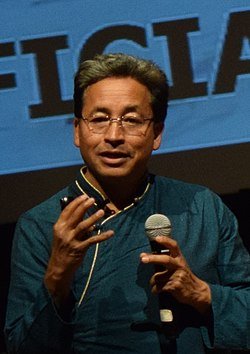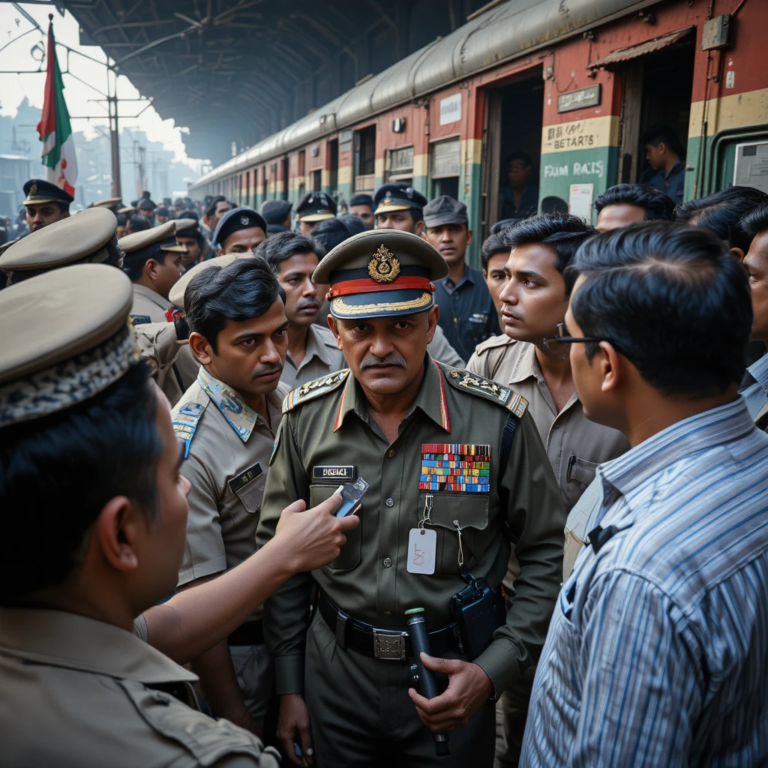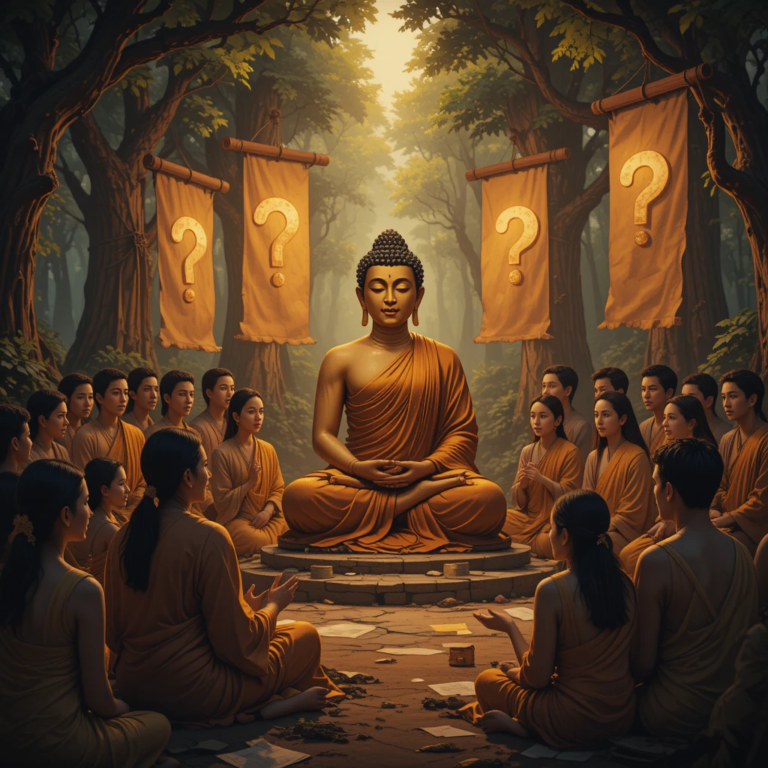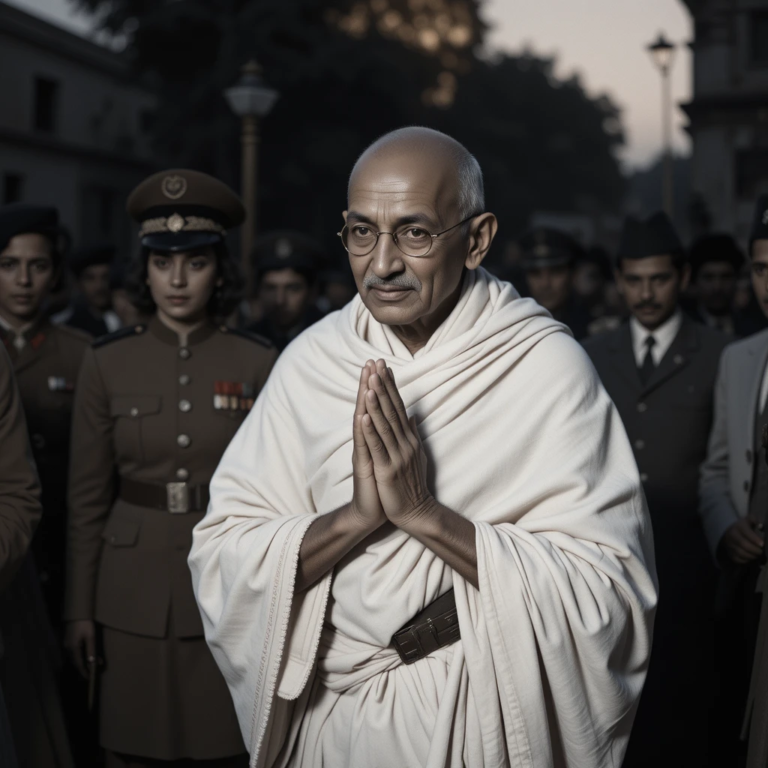1. Introduction
Mohandas Karamchand Gandhi, globally known as Mahatma Gandhi, and revered in India as Bapu and the Father of the Nation, remains one of the most influential figures in modern history.^1 His leadership in India’s independence movement transformed a colonized nation into a free republic—not through violence, but through moral force grounded in truth (Satya) and non-violence (Ahimsa).^2
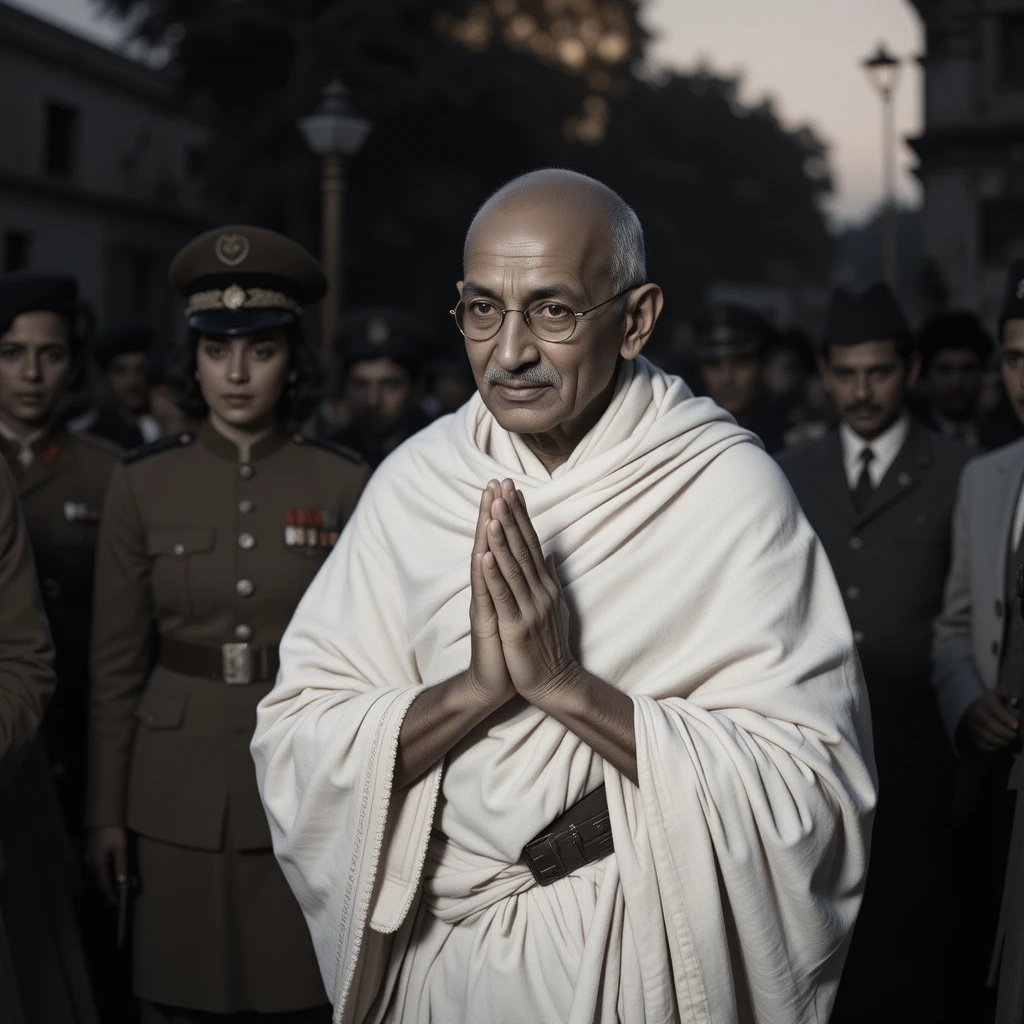
Table of Contents
Gandhi’s vision extended beyond political liberation. He sought a moral, social, and economic transformation of Indian society, emphasizing unity, justice, and self-reliance. His methods inspired millions to participate in mass movements, challenging British imperialism without bloodshed.^3 Globally, leaders such as Martin Luther King Jr., Nelson Mandela, and Aung San Suu Kyi adopted his principles to guide struggles against oppression.^4
Gandhi’s life demonstrates the evolution of a shy barrister into a moral and political leader whose influence shaped the destiny of India. This article examines his life, philosophy, movements, social reforms, role in partition and independence, assassination, global influence, criticisms, and enduring legacy.
2. Early Life and Education
2.1 Birth and Family Background
Mohandas Karamchand Gandhi was born on 2 October 1869, in Porbandar, Gujarat, India, to a Bania (Vaishya) family engaged in trade and administration.^5 His father, Karamchand Uttamchand Gandhi, served as Diwan of Porbandar and later Rajkot, known for honesty and administrative skill.^6
His mother, Putlibai, was deeply religious, practicing Vaishnav devotion, fasting, and self-discipline. Her spiritual influence profoundly shaped Gandhi’s moral conscience and later inspired his emphasis on ethical living, simplicity, and non-violence.^7
2.2 Childhood and Schooling
Gandhi was a shy and introverted child, attending:
- Primary school in Porbandar
- Alfred High School, Rajkot
Though not academically exceptional, he demonstrated discipline, honesty, and curiosity.^8 At age 13, he married Kasturba Makhanji, a child marriage that later informed his critiques of social practices and belief in societal reform.^9
2.3 Religious and Ethical Influence
Gandhi’s upbringing exposed him to:
- Hinduism (Vaishnav traditions emphasizing non-violence and devotion)
- Jainism (Ahimsa and Aparigraha)
- Respect for other faiths such as Islam, Christianity, and Zoroastrianism
This pluralistic spiritual environment laid the foundation for his lifelong advocacy for religious harmony and tolerance.^10
2.4 Journey to London (1888–1891)
At 18, Gandhi traveled to London to study law at the Inner Temple. Initially, family and caste councils opposed this because crossing the seas was considered ritually impure. Gandhi maintained strict vegetarianism and moral discipline to gain approval.^11
During this period, he encountered influential ideas:
- Henry Salt’s A Plea for Vegetarianism, strengthening his commitment to vegetarianism
- Theosophical teachings and study of the Bhagavad Gita, forming the philosophical base for non-violence and duty
- Western philosophers, inspiring his understanding of moral governance and civic responsibility^12
He completed his degree in 1891 and returned to India to begin his legal career.
2.5 Early Struggles in India (1891–1893)
Gandhi faced difficulties establishing a law practice in Bombay due to his introverted nature and inexperience. Eventually, he accepted a contract to work in South Africa, which became the turning point in his life and political philosophy.^13
3. Formative Years in South Africa (1893–1914)
3.1 Arrival and Racial Discrimination
In 1893, Gandhi arrived in Durban, South Africa, to serve as a legal consultant. He immediately faced racial discrimination:
- Denied entry to first-class train compartments
- Refused lodging in hotels
- Humiliated in court and public spaces
These experiences awakened his commitment to justice and equality, laying the foundation for civil resistance movements.^14
3.2 Formation of Indian Community Organizations
To organize the Indian diaspora, Gandhi helped establish the Natal Indian Congress (1894), advocating for civil rights and peaceful negotiation with colonial authorities.^15
3.3 Birth of Satyagraha
Satyagraha, meaning holding firmly to truth, combined principles from Hindu, Jain, and Christian ethics, applied through peaceful resistance to injustice.^16
Key Campaigns in South Africa:
- Natal Protest (1894–1897) – petitioned against discriminatory taxes
- Transvaal Struggle (1906–1914) – organized mass refusal to register under oppressive laws
- Social Reforms – promoted women’s participation and Hindu-Muslim unity^17
By 1914, Gandhi perfected Satyagraha, demonstrating that moral force could challenge oppressive governments.^18
3.4 Influence on Gandhi’s Philosophy
- Ethics over political power
- Mass mobilization of ordinary people
- Personal discipline: fasting, simplicity, and non-violence as political tools^19
3.5 Return to India (1915)
Gandhi returned to India as a respected and confident leader, ready to address social and political issues using non-violent methods.^20
4. Entry into Indian Politics (1915–1920)
4.1 Association with Gopal Krishna Gokhale
Gokhale mentored Gandhi, emphasizing constitutional reform, negotiation, and mass engagement. Gandhi adopted a strategy that blended political activism with social reform.^21
4.2 Early Social Reform Efforts
Gandhi worked on:
- Eradicating untouchability
- Promoting women’s education
- Reviving khadi for economic self-reliance^22
4.3 Champaran Satyagraha (1917)
Gandhi led farmers in Champaran, Bihar, against indigo planters. Through peaceful investigation, negotiation, and public mobilization, reforms were enacted granting farmers fair rents.^23
4.4 Kheda Satyagraha (1918)
Farmers in Kheda, Gujarat, unable to pay taxes due to crop failure, peacefully withheld tax payments. British authorities eventually suspended tax collection, marking another non-violent victory.^24
4.5 Ahmedabad Mill Strike (1918)
Gandhi mediated a textile mill strike, securing wage increases without violence. This demonstrated his ability to combine ethical leadership with practical solutions.^25
5. Gandhi and Mass Movements
5.1 Non-Cooperation Movement (1920–1922)
Prompted by the Jallianwala Bagh Massacre (1919) and Rowlatt Act, Gandhi called for peaceful non-cooperation:
- Boycott British goods, schools, and courts
- Resign from government jobs
- Refuse taxes
Millions participated, including women, signaling the strength of mass non-violent resistance.^26
The movement was suspended after the Chauri Chaura incident (1922), where violence erupted, emphasizing Gandhi’s strict commitment to Ahimsa.^27
5.2 Salt Satyagraha and Civil Disobedience (1930–1934)
Gandhi led the Dandi March (1930) to protest the British salt monopoly, inspiring nationwide civil disobedience. The movement demonstrated how symbolic acts of defiance could mobilize millions and gain global attention.^28
5.3 Round Table Conferences (1930–1932)
Gandhi represented the Indian National Congress, negotiating for self-rule and social reforms while emphasizing the upliftment of untouchables.^29
6. Philosophy and Ideology
- Satyagraha: Moral force stronger than violence^30
- Ahimsa: Non-violence as an ethical and political tool^31
- Swaraj: Self-rule encompassing moral, social, and economic independence^32
- Sarvodaya: Welfare of all, especially marginalized communities^33
- Trusteeship and Economic Ethics: Ethical management of resources for societal benefit^34
- Religious Tolerance: Advocacy for interfaith harmony and opposition to communalism^35
7. Social Reform
- Eradication of untouchability; participation of Harijans in mainstream society^36
- Women’s participation in protests and education initiatives^37
- Promotion of khadi and economic self-reliance^38
- Focus on village development and rural economy^39
8. Quit India Movement (1942)
Gandhi launched the Quit India Movement, calling for immediate British withdrawal with the slogan “Do or Die.”^40 Mass protests, strikes, and civil disobedience ensued, though Gandhi and leaders were imprisoned. The movement demonstrated India’s national unity and resolve.^41
9. Partition and Independence
Gandhi tried to prevent Hindu-Muslim violence, undertaking fasts and personal appeals.^42 Despite his efforts, Partition occurred in 1947, resulting in massive communal violence and displacement.^43
10. Assassination and Aftermath (1948)
Gandhi was assassinated on 30 January 1948 by Nathuram Godse, shocking India and the world.^44 His death emphasized the fragility of peace in a newly independent India.^45
11. Global Influence
- Inspired Martin Luther King Jr., Nelson Mandela, Aung San Suu Kyi^46
- Non-violence became a universal principle of resistance^47
12. Criticisms
- Gandhi’s non-violence seen as impractical by some leaders^48
- Criticized by Dr. Ambedkar for not aggressively challenging caste system^49
- Economic policies (villages, khadi) considered anti-modernization^50
13. Legacy
- Inspired India’s Constitutional values^51
- Gandhian institutions and Ashrams promoted education, rural development, and ethical leadership^52
- Principles continue to guide peace movements, social activism, and governance^53
14. Conclusion
Mahatma Gandhi’s life epitomized the intersection of morality, politics, and social reform. His contributions shaped India’s freedom struggle and inspired global movements for justice and human rights. Gandhi’s enduring message is that truth, non-violence, and moral courage are powerful tools for societal transformation.^54
Footnotes
- Judith M. Brown, Gandhi: Prisoner of Hope (New Haven: Yale University Press, 1989), 1.
- Louis Fischer, The Life of Mahatma Gandhi (New York: Harper & Row, 1950), 25.
- Anthony J. Parel, Gandhi’s Philosophy and the Quest for Harmony (Cambridge: Cambridge University Press, 2006), 14.
- Dennis Dalton, Mahatma Gandhi: Nonviolent Power in Action (New York: Columbia University Press, 1993), 215.
- Judith M. Brown, Gandhi: A Life (New Haven: Yale University Press, 2011), 15.
- Stanley Wolpert, Gandhi’s Passion: The Life and Legacy of Mahatma Gandhi (Oxford: Oxford University Press, 2002), 20.
- Louis Fischer, The Life of Mahatma Gandhi, 12.
- Ramachandra Guha, Gandhi: The Years That Changed the World, 1914–1948 (London: Penguin, 2018), 7.
- Judith M. Brown, Gandhi: Prisoner of Hope, 18.
- Bhikhu Parekh, Gandhi: The Meaning of Mahatma (London: Penguin Books India, 1997), 35.
- Dennis Dalton, Mahatma Gandhi: Nonviolent Power in Action, 23.
- Anthony J. Parel, Gandhi’s Philosophy and the Quest for Harmony, 22–23.
- Judith M. Brown, Gandhi: A Life, 35.
- Ramachandra Guha, Gandhi Before India (New Delhi: Penguin, 2013), 112.
- Dennis Dalton, Mahatma Gandhi: Nonviolent Power in Action, 45.
- Anthony J. Parel, Gandhi’s Philosophy and the Quest for Harmony, 50.
- Judith M. Brown, Gandhi: A Life, 60.
- Louis Fischer, The Life of Mahatma Gandhi, 90.
- Dennis Dalton, Mahatma Gandhi: Nonviolent Power in Action, 65.
- Ramachandra Guha, Gandhi: The Years That Changed the World, 80.
- A. R. Desai, Social Background of Indian Nationalism (Mumbai: Popular Prakashan, 1948), 110.
- Bhikhu Parekh, Gandhi: The Meaning of Mahatma, 45.
- Ramachandra Guha, Gandhi: The Years That Changed the World, 95.
- Dennis Dalton, Mahatma Gandhi: Nonviolent Power in Action, 100.
- Louis Fischer, The Life of Mahatma Gandhi, 130.
- Judith M. Brown, Gandhi: Prisoner of Hope, 145.
- Stanley Wolpert, Gandhi’s Passion, 155.
- Ramachandra Guha, Gandhi: The Years That Changed the World, 200.
- Anthony J. Parel, Gandhi’s Philosophy and the Quest for Harmony, 220.
- M. K. Gandhi, An Autobiography: The Story of My Experiments with Truth (Ahmedabad: Navajivan Publishing House, 1927), 210.
- Ibid., 220.
- M. K. Gandhi, Hind Swaraj or Indian Home Rule (Ahmedabad: Navajivan Publishing House, 1909), 40.
- Bhikhu Parekh, Gandhi: The Meaning of Mahatma, 55.
- Anthony J. Parel, Gandhi’s Philosophy and the Quest for Harmony, 65.
- Ramachandra Guha, Gandhi: The Years That Changed the World, 230.
- Dennis Dalton, Mahatma Gandhi: Nonviolent Power in Action, 120.
- Judith M. Brown, Gandhi: A Life, 180.
- Stanley Wolpert, Gandhi’s Passion, 145.
- Ramachandra Guha, Gandhi Before India, 150.
- Judith M. Brown, Gandhi: Prisoner of Hope, 250.
- Louis Fischer, The Life of Mahatma Gandhi, 270.
- Anthony J. Parel, Gandhi’s Philosophy and the Quest for Harmony, 280.
- Ramachandra Guha, Gandhi: The Years That Changed the World, 310.
- Dennis Dalton, Mahatma Gandhi: Nonviolent Power in Action, 340.
- Stanley Wolpert, Gandhi’s Passion, 360.
- Judith M. Brown, Gandhi: A Life, 400.
- Anthony J. Parel, Gandhi’s Philosophy and the Quest for Harmony, 420.
- Bhikhu Parekh, Gandhi: The Meaning of Mahatma, 125.
- A. R. Desai, Social Background of Indian Nationalism, 135.
- Ramachandra Guha, Gandhi: The Years That Changed the World, 450.
- Ministry of Culture, Government of India, National Portal of India – Mahatma Gandhi Biography, https://www.india.gov.in.
- Gandhi Heritage Portal, https://www.gandhiheritageportal.org.
- Encyclopaedia Britannica, “Mahatma Gandhi,” https://www.britannica.com/biography/Mahatma-Gandhi.
- Louis Fischer, The Life of Mahatma Gandhi, 500.

